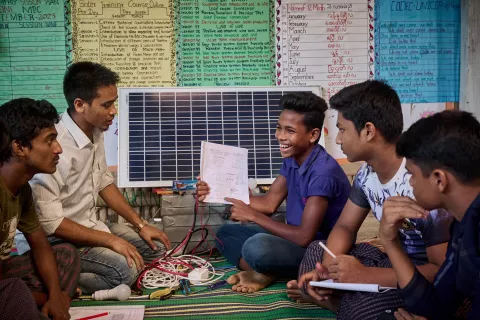Online learning was exciting but more challenging

When COVID-19 hit Bhutan, I thought the situation wouldn’t be as bad as in other parts of the world.
I was wrong.
The virus spread fast and disrupted education across the whole country. Schools and all other learning institutions were closed. Perhaps for the first time in the country’s history, students like me stopped going to school.
Going online for classes was exciting, but the excitement came with challenges.
Teachers and students alike were completely new to the system and had difficulties attending and participating in the online classes. Together we had to learn how to use online platforms such as Google Meet, Zoom and Google classroom.
Most Bhutanese students live in rural areas and have to help their parents with household chores and errands. Students of all ages were caught between helping parents and attending classes online.
Internet in Bhutan is too expensive, despite the student data package offers that the Ministry of Education came up with.
Bhutan connected to the Internet in 1999, fairly late in comparison to other countries. The pandemic pushed us all to go online just as the country was starting to catch up with the rest of the world in terms of its connectivity.
While not being able to understand the lessons taught online was a challenge for those who managed to get online, most rural students had no smartphones. Shops ran out of smartphones, but many parents found that buying a mobile phone for each school-going child was beyond their means. Fortunately, my family managed to get me and my younger sibling a phone each. But I soon realized that having a phone was not enough.
In remote places like Dunglangang, Tsirang in central Bhutan, where I live, connecting to the internet is a major problem, compounded by very high data charges. Connectivity is especially bad when I am out in the fields or helping my parents herd cattle. When I managed to get some time to go online, I often couldn’t connect and join most of the classes. Still, I studied whenever I got some free time and I wrote most of my assignments late in the night and early morning.
But it was a huge struggle to keep up with the lessons. With no one reminding us to study - unlike in normal classes - online learning required us to rely on our own grit and zeal for learning.
Our online classes were an uncomfortable experience. Technology is meant to be empowering and democratic. But the reality of the digital divide revealed more than issues of connectivity. It exposed the poverty and inequality issues in our society, villages and homes.
For my siblings and I, and possibly for many children like us, being in school offered us a chance to focus on learning and to be away from troubles at home. Education for many of us is the only hope to change our lives, and poor access to digital learning threatens to take away this very hope.
Despite the challenges, we cannot imagine what sorry state we would be in if it weren’t for remote learning. While it can never replace the benefits of in-person classes, the pandemic has given an urgency to governments to bridge the digital gap in South Asian countries.
Governments and institutions must make more effort to bridge this technological divide and provide equal opportunities to all children. A solution must go beyond providing gadgets and internet. It is about addressing the issues that hamper learning, poverty and inequality. It is also about empowering teachers to use technology and giving support to parents as well.
Bridging the digital divide is an investment that enables us to continue learning and preserve our hopes for a brighter life.
By Geeta Acharya, Grade 10 student at Damphu Central School in Tsirang district.



